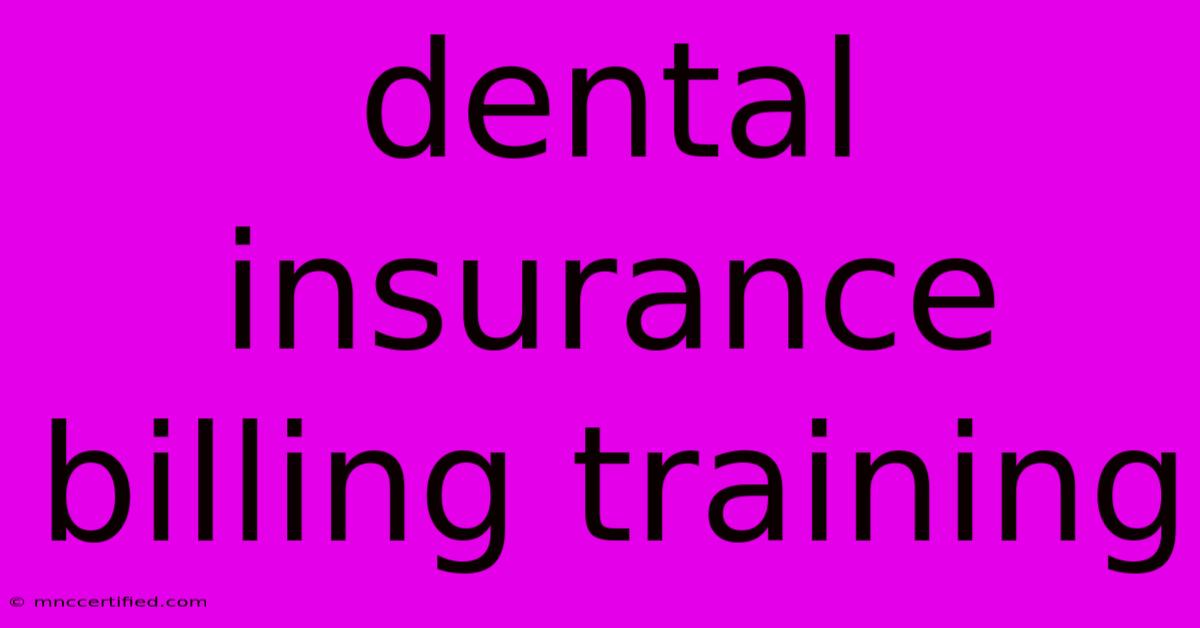Dental Insurance Billing Training

Table of Contents
Mastering Dental Insurance Billing: A Comprehensive Training Guide
The world of dental insurance billing can feel like navigating a complex maze. Incorrect claims can lead to delayed payments, revenue loss, and frustrating administrative headaches. This comprehensive guide provides essential training on dental insurance billing, equipping you with the knowledge and skills to streamline your practice's financial processes and improve overall efficiency.
Understanding the Fundamentals of Dental Insurance Billing
Before diving into the specifics, let's lay a solid foundation. Understanding the core principles is crucial for success in dental insurance billing.
Key Terminology: Demystifying the Jargon
- Participating Provider (PPO): A dentist who has a contract with a specific insurance company.
- Non-Participating Provider (Non-PPO): A dentist who doesn't have a contract with the insurance company.
- Explanation of Benefits (EOB): A statement sent by the insurance company detailing the services covered and payments made.
- Pre-authorization: Obtaining approval from the insurance company before performing certain procedures.
- Claim: A formal request for payment submitted to the insurance company.
- Coordination of Benefits (COB): A process to determine which insurance company is primarily responsible for payment when a patient has multiple insurance plans.
Types of Dental Insurance Plans: Navigating the Landscape
Familiarizing yourself with different types of dental insurance plans is paramount. Common plans include:
- HMO (Health Maintenance Organization): Typically offers lower premiums but restricts patients to a network of dentists.
- PPO (Preferred Provider Organization): Provides more flexibility in choosing dentists but may have higher premiums.
- DHMO (Dental Health Maintenance Organization): Similar to HMOs but specifically for dental care.
- Fee-for-Service: Patients pay for services upfront and then submit claims for reimbursement.
The Claim Submission Process: A Step-by-Step Guide
Accurate and timely claim submission is the cornerstone of successful dental insurance billing. Here's a detailed breakdown:
1. Gathering Necessary Information: Accuracy is Key
Before submitting a claim, ensure you have all the necessary information:
- Patient's Insurance Information: Policy number, group number, subscriber ID, and effective dates.
- Treatment Codes (CDT Codes): Accurate and specific codes representing the dental procedures performed. Using incorrect codes is a major cause of claim denials.
- Patient's Demographic Information: Full name, address, date of birth, and contact information.
- Date of Service: The date each procedure was performed.
2. Completing the Claim Form: Precision Matters
Dental claim forms vary depending on the insurance company. Pay close attention to detail and ensure all fields are accurately and completely filled out. Common errors include missing information or incorrect coding.
3. Electronic vs. Paper Claims: Choosing the Right Method
Electronic claims submission is generally faster and more efficient than paper claims. Many insurance companies offer online portals for electronic submission, significantly reducing processing time.
4. Tracking Claims: Monitoring for Success
Regularly track the status of submitted claims. Follow up on any delayed or denied claims promptly. Effective claim tracking software can streamline this process.
Handling Denied Claims: Troubleshooting and Resolution
Claim denials are inevitable, but effective handling can minimize their impact. Understanding common reasons for denials is crucial:
- Incorrect or Missing Information: Double-check all details on the claim form.
- Pre-authorization Issues: Ensure you obtained necessary pre-authorization for specific procedures.
- Incorrect Coding: Verify the accuracy of CDT codes used.
- Benefit Maximums: Confirm the patient hasn't reached their annual benefit maximum.
Proactive strategies to minimize denials include: verifying patient insurance benefits before treatment, utilizing accurate coding, and maintaining detailed patient records.
Advanced Techniques and Best Practices
To truly master dental insurance billing, consider these advanced strategies:
- Investing in Dental Billing Software: Streamlines claims submission, tracking, and reporting.
- Staying Updated on Insurance Regulations: Changes in regulations can significantly impact billing practices. Regularly check for updates from your state's dental board and the insurance companies you work with.
- Understanding Managed Care Contracts: Thoroughly review and understand your contracts with insurance companies.
- Implementing a Robust Training Program: Regularly train your staff on the latest billing procedures and best practices.
Conclusion: Building a Strong Foundation for Success
Mastering dental insurance billing is essential for the financial health of any dental practice. By understanding the fundamentals, following a meticulous claim submission process, effectively handling denials, and embracing advanced techniques, you can significantly improve your practice’s revenue cycle and focus on providing exceptional patient care. Continuous learning and staying updated on industry best practices are key to long-term success in this crucial area.

Thank you for visiting our website wich cover about Dental Insurance Billing Training. We hope the information provided has been useful to you. Feel free to contact us if you have any questions or need further assistance. See you next time and dont miss to bookmark.
Featured Posts
-
Lawrences Chocolate Gown After Baby
Nov 19, 2024
-
Are Sealants Covered By Insurance
Nov 19, 2024
-
Gmails Dummy Email Addresses Coming Soon
Nov 19, 2024
-
Ksis Prediction Right Sidemen Wembley Sold Out
Nov 19, 2024
-
No Ronaldo Portugal Squad Selection
Nov 19, 2024